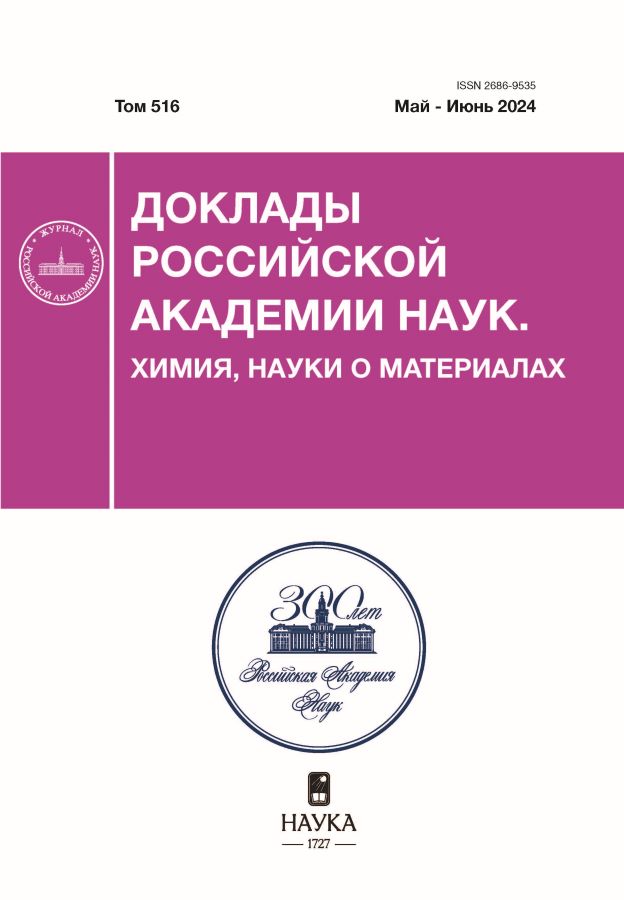The change of phase composition and the morphology of particles of hydrothermal titanosilicate precipitates during their aging
- Autores: Gerasimova L.G.1, Shchukina E.S.1, Nikolaev A.I.1, Vinogradova S.V.1
-
Afiliações:
- Tananaev Institute of Chemistry – Subdivision of the Federal Research Centre “Kola Science Centre of the Russian Academy of Sciences”
- Edição: Volume 516, Nº 1 (2024)
- Páginas: 21-29
- Seção: CHEMICAL TECHNOLOGY
- URL: https://ter-arkhiv.ru/2686-9535/article/view/651905
- DOI: https://doi.org/10.31857/S2686953524030035
- EDN: https://elibrary.ru/ZJDQRW
- ID: 651905
Citar
Texto integral
Resumo
During the study of phase formation under conditions of hydrothermal synthesis of alkaline titanosilicate systems (NH₄)₂TiO(SO₄)₂⋅H₂O или TiOSO₄⋅H₂O-Na₂SiO₃-NaOH-H₂O it was found that the formed titanosilicate solid phases differ both in composition and structure. The process of their aging under conditions of long-term exposure without forced heating is accompanied mainly by the loss of free water without noticeable structural and morphological changes. The exposure to the temperature of 70–100°С significantly accelerates the process of solid phase transformation. In these conditions, a porous system of particles is formed, which is confirmed by an increase in their specific surface area and total pore volume, as well as by an increase in the activity of the powders to absorb single- and double-charged cations. The effectiveness of hydrochloric acid treatment of fresh and especially aged precipitates on the ordering of the structure with the formation of crystals of a clear frame shape, inherent in the minerals zorite and ivanyukite, which contributes to increasing the sorption capacity of the final product is shown. The obtained results are used to adjust the technological regulations, which are used to test the technology of titanosilicate sorbent on the pilot plant.
Texto integral
Sobre autores
L. Gerasimova
Tananaev Institute of Chemistry – Subdivision of the Federal Research Centre “Kola Science Centre of the Russian Academy of Sciences”
Autor responsável pela correspondência
Email: l.gerasimova@ksc.ru
Rússia, 184209 Apatity, Murmansk region
E. Shchukina
Tananaev Institute of Chemistry – Subdivision of the Federal Research Centre “Kola Science Centre of the Russian Academy of Sciences”
Email: l.gerasimova@ksc.ru
Rússia, 184209 Apatity, Murmansk region
A. Nikolaev
Tananaev Institute of Chemistry – Subdivision of the Federal Research Centre “Kola Science Centre of the Russian Academy of Sciences”
Email: l.gerasimova@ksc.ru
Corresponding Member of the RAS
Rússia, 184209 Apatity, Murmansk regionS. Vinogradova
Tananaev Institute of Chemistry – Subdivision of the Federal Research Centre “Kola Science Centre of the Russian Academy of Sciences”
Email: l.gerasimova@ksc.ru
Rússia, 184209 Apatity, Murmansk region
Bibliografia
- Huang Z., Chen C., Хie J., Wang Z. // J. Anal. Appl. Pyrolysis. 2016. V. 118. P. 225–230. https://doi.org/10.1016/j.jaap.2016.02.006
- Venkataraman К., Thomas G.S. // ACS Omega. 2022. V. 7. № 6. P. 5393–5400. https://doi.org/10.1021/acsomega.1c06630
- Чемерис О.Н. Физико-химическое исследование гидроксидов европия, гадолиния, тербия и систем на их основе: Дис. ... канд. хим. наук: 02.00.01: Краснодар, 2003. 125 с.
- Чалый В.П. Гидроокиси металлов (Закономерности образования, состав, структура и свойства). Киев: Наукова думка, 1972. 153 с.
- Zubkova N.V., Pushcharovsky D.Yu., Giester G., Pekov I.V., Turchkova A.G., Chukanov N.V., Tillmanns E. // Crystallogr. Rep. 2005. V. 50. № 3. P. 367–373. https://doi.org/10.1134/1.1927591
- Du H., Zhou F., Pang W., Yue Y. // Microporous Mater. 1996. V. 7. № 2–3. P. 73–80. https://doi.org/10.1016/0927-6513(96)00014-4
- Lin Z., Ferdov S. // Microporous Mesoporous Mater. 2022. V. 335. 111835. https://doi.org/10.1016/j.micromeso.2022.111835
- Gerasimova L.G., Nikolaev A.I., Artemenkov A.G., Shchukina E.S., Maslova M.V., Kiselev Yu.G. // Theor. Found. Chem. Eng. 2023. V. 57. № 5. P. 1066–1072. https://doi.org/10.1134/S0040579523050093
- Samburov G.O., Kalashnikova G.O., Panikorovskii T.L., Bocharov V.N., Kasikov A.G., Selivanova E.A., Bazai A.V., Bernadskaya D., Yakovenchuk V.N., Krivovichev S.V. // Crystals. 2022. V. 12. № 3. 311. https://doi.org/10.3390/cryst12030311
- Panikorovskii T.L., Yakovenchuk V.N., Yanicheva N.Yu., Pakhomovsky Ya.A., Shilovskikh V.V., Bocharov V.N., Krivovichev S.V. // Mineral. Mag. 2021. V. 85. № 4. P. 607–619. https://doi.org/10.1180/mgm.2021.51
- Герасимова Л.Г., Щукина Е.С., Маслова М.В., Николаев А.И. // Докл. РАН. Химия, науки о материалах. 2023. Т. 513. С. 86–92. https://doi.org/10.31857/S2686953523700255
- Щукина Е.С., Герасимова Л.Г., Охрименко Р.Ф. // Хим. технол. 2012. Т. 13. № 5. С. 263–267.
- Gerasimova L.G., Maslova M.V., Shchukina E.S. // Theor. Found. Chem. Eng. 2009. V. 43. № 4. P. 464–467. https://doi.org/10.1134/S0040579509040186
- Thomas М., Bąk J., Królikowska J. // Desalination and Water Treatment. 2020. V. 208. P. 261–272. https://doi.org/10.5004/dwt.2020.26689
- Гимаева М.В., Валинурова Э.Р., Игдавлетова Д.К., Петрова О.П., Кудашева Ф.Х. // Сорбционные и хроматографические процессы. 2012. Т. 12. № 2. С. 267–273.
- Герасимова Л.Г., Щукина Е.С., Маслова М.В., Семушин В.В. // Изв. ВУЗов. Сер. Химия и хим. технол. 2021. Т. 64. № 8. С. 115–122. https://doi.org/10.6060/ivkkt.20216408.6411
Arquivos suplementares

















